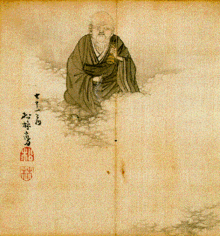Puhua
| Puhua | |
|---|---|
| Zhenzhou Pǔhuà (鎮州普化) |
|

A modern depiction of the folkloric Puhua ringing his taku (hand-bell) in the clouds, painted by artist and shakuhachi player John Singer in 2001.
|
|
| Religion | Buddhism |
| School | Mahāyāna |
| Lineage | Chán (Zen) |
| Sect | Linji (Rinzai) |
| Monastic name | P'u Hua Chán Shih (Fuke-Zenji) |
| Personal | |
| Nationality | Tang Chinese |
| Born | 770 China (Tang Dynasty) |
| Died | Ambiguous (840 or 860) – {see below} China (Tang Dynasty) |
| Senior posting | |
| Predecessor | Panshan Baoji |
| Successor |
Debatable/Ambiguous: Ennin and/or Zhang Bai and/or Chang Po (Chōhaku) |
| Rank | 1st 'Patriarch' of Fuke Zen |
| Religious career | |
| Teacher | Panshan Baoji, Linji Yixuan |
| Students | Ennin, Zhang Bai, Chang Po (Chōhaku) |
| Profession | Mendicant, Zen master, religious leader |
Zhenzhou Puhua (Chinese: traditional: 鎮州普化, simplified: 普化, pinyin: Zhenzhou Pǔhuà; Japanese: Jinshu Fuke, honorifically Fuke Zenji (lit. "Zen master Fuke")—allegedly ca. 770-840 or 860), also called P'u-k'o, and best known by his Japanese name, Fuke, was a potentially mythical Chinese Chán (Zen) master, monk-priest, wanderer and eccentric, whose existence and many affairs were advanced and likely fabricated by the now defunct Fuke Zen or Hotto-ha sect, or sub-sect, of Japanese Rinzai Zen Buddhism in the 17th or 18th century with the publication of the later-disconfirmed document, the Kyotaku Denki (虚鐸伝記), probably first published around 1640. For the komusō (虚無僧) monks of the Fuke sect, he was considered the traditional antecedent—at least in spiritual or philosophical terms—of their order, which was formally established in Edo Japan. It is more likely that the ideological roots of the sect derived from the Rinzai poet and iconoclast Ikkyū and the monk Shinchi Kakushin (心地覺心) who traveled to and from China and Japan in the 13th century. Still according to some accounts the sect is simply a more direct derivative of the Rinzai school and its teachings.
The few records of Puhua's life and affairs are those accounted, if only briefly, in several East Asian religious or historical references. One of the only credible sources on his life is to be found in the Tang Dynasty Record of Linji, wherein he is portrayed as an obscure student and eventual dharma heir of Panshan Baoji, as well as a friend, colleague, student and/or contemporary of Linji Yixuan, who founded the Linji (臨済宗 Rinzai) sect in China. This implies that he may have been a real individual, although the legends surrounding him in the Kyotaku Denki which connect him to the Fuke sect have been proven as fabrications created to further the komusōs' benefits under the Tokugawa shogunate.
...
Wikipedia
